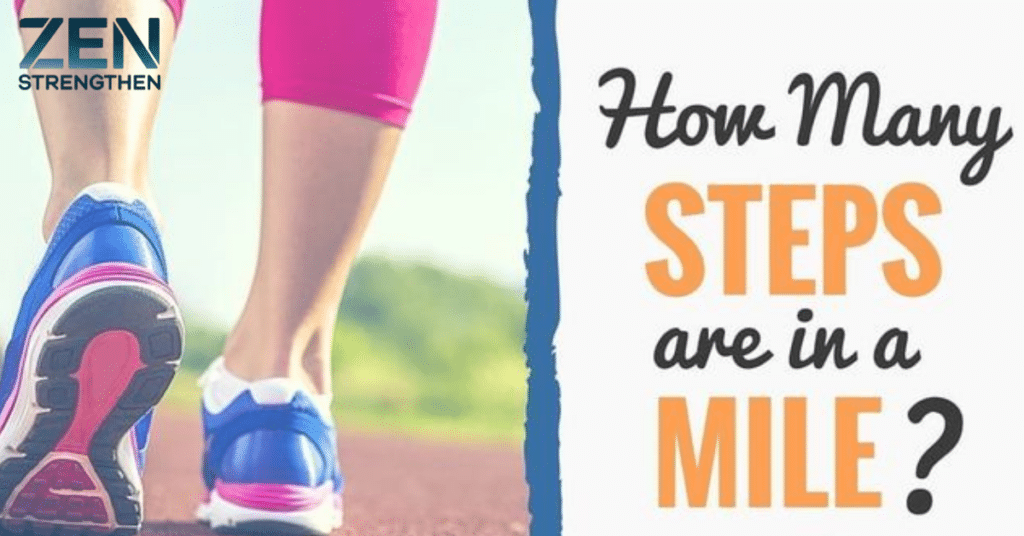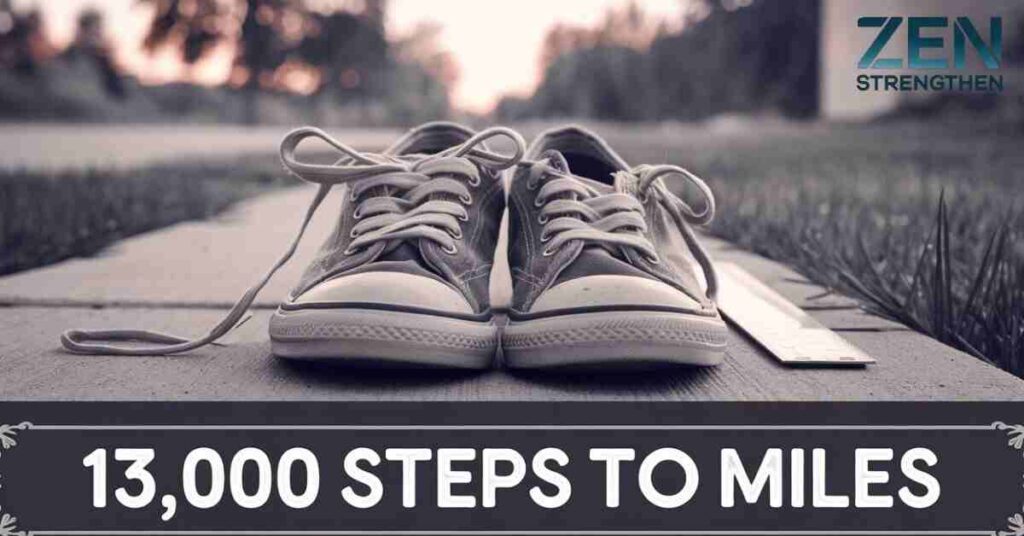In an era where health and fitness dominate our daily conversations, the humble act of walking has emerged as a powerful tool for wellness. But as we chase step counts on our digital devices, a question often arises: just how far are we really going? Today, we’re diving deep into the world of 13000 steps to miles – a number that’s caught the attention of health enthusiasts and fitness trackers alike.
Let’s unravel the mysteries behind this milestone and explore its impact on our overall well-being.
Decoding the Step-to-Mile Equation

The journey from steps to miles isn’t as straightforward as one might think. Several factors come into play when converting your step count to distance covered:
- Stride length: The distance between the heel print of one foot to the heel print of the other foot
- Walking pace: Your speed of movement
- Terrain: The type of surface you’re walking on (flat, hilly, etc.)
- Height: Taller individuals generally have longer strides
- Age: Stride length can change as we age
- Gender: On average, men tend to have slightly longer strides than women
On average, a person’s stride length ranges from 2.1 to 2.5 feet. Using this range, we can estimate that 13000 steps roughly equate to:
| Stride Length | Approximate Miles | Approximate Kilometers |
| 2.1 feet | 5.17 miles | 8.32 km |
| 2.2 feet | 5.42 miles | 8.72 km |
| 2.3 feet | 5.67 miles | 9.12 km |
| 2.4 feet | 5.92 miles | 9.52 km |
| 2.5 feet | 6.17 miles | 9.93 km |
“Your stride is as unique as your fingerprint. Factors like height, leg length, and even mood can affect how far you step!” – Dr. Jane Walker, Exercise Physiologist
To calculate your personal step-to-mile ratio:
- Measure a known distance (e.g., 100 feet or 30 meters)
- Count your steps as you walk this distance at your normal pace
- Divide the distance by your step count
For example, if you take 40 steps to cover 100 feet: 100 feet ÷ 40 steps = 2.5 feet per step
Now you can more accurately estimate your miles!
Time Investment: Walking vs. Running 13000 Steps
The time it takes to accumulate 13000 steps is how many miles varies significantly based on your chosen activity level. Let’s break it down:
Walking Scenarios
| Pace | Speed | Estimated Time |
| Casual stroll | 2 mph | 3 – 3.5 hours |
| Moderate walk | 3 mph | 2 – 2.5 hours |
| Brisk walk | 4 mph | 1.5 – 2 hours |
| Power walking | 4.5-5 mph | 1.25 – 1.5 hours |
Running Scenarios
| Pace | Speed | Estimated Time |
| Light jog | 5 mph | 1 – 1.25 hours |
| Steady run | 6 mph | 50 – 60 minutes |
| Moderate run | 7 mph | 45 – 55 minutes |
| Fast run | 8 mph | 40 – 50 minutes |
| Sprint intervals | Varied | 30 – 45 minutes |
Remember, these are estimates. Your actual time may vary based on fitness level, terrain, and other factors.
The Health Impact: Unveiling the Benefits of 13000 Steps
Reaching “13,000 steps” a day places you firmly in the highly active lifestyle category. But what does this mean for your health? Let’s explore the multifaceted benefits:
Calorie Burn Analysis
The number of calories burned depends on factors like weight, walking pace, and terrain. Here’s a more detailed breakdown:
| Body Weight | Calories Burned (13,000 steps) | ||
| Casual Walk | Brisk Walk | Power Walk | |
| 130 lbs | 433 – 520 | 590 – 650 | 650 – 710 |
| 155 lbs | 516 – 620 | 703 – 775 | 775 – 845 |
| 180 lbs | 600 – 720 | 817 – 900 | 900 – 980 |
| 205 lbs | 683 – 820 | 930 – 1025 | 1025 – 1115 |
“Regular walking can burn as many calories as jogging when you do it for the same amount of time!” – American Heart Association
Impact on Body Composition

While 13,000 steps won’t magically melt away belly fat, it can contribute significantly to overall weight loss and improved body composition. Here’s how:
- Calorie Deficit: Walking 13,000 steps can create a substantial calorie deficit when combined with a balanced diet.
- Muscle Engagement: Regular walking engages multiple muscle groups, promoting lean muscle mass development.
- Metabolic Boost: Consistent physical activity can increase your resting metabolic rate.
- Fat Oxidation: Moderate-intensity exercise like brisk walking is excellent for burning fat as fuel.
Cardiovascular Health Improvements
Walking 13,000 steps a day is an excellent form of aerobic exercise. Here’s how it benefits your heart:
- Lower Blood Pressure: Regular walking can reduce both systolic and diastolic blood pressure.
- Improved Cholesterol Profile: It can increase HDL (good) cholesterol and lower LDL (bad) cholesterol.
- Reduced Heart Disease Risk: The Framingham Heart Study found that men who walked more than 10,000 steps per day had a 24% lower risk of heart disease.
- Better Circulation: Walking improves blood flow throughout the body, reducing the risk of blood clots.
Mental Health and Cognitive Benefits
The benefits of walking extend well beyond physical health. Here’s how your 13,000 steps can boost your brain:
- Mood Enhancement: Walking releases endorphins, the body’s natural “feel-good” hormones.
- Stress Reduction: Regular physical activity can lower cortisol levels, reducing stress.
- Improved Cognitive Function: Studies show that walking can improve memory, attention, and decision-making skills.
- Reduced Risk of Depression: A large-scale study found that walking for an hour a day reduced the risk of major depression by 26%.
- Better Sleep: Regular exercise can improve sleep quality and duration.
Beyond the Number: Understanding Daily Step Counts
While 13,000 steps is an admirable goal, it’s essential to understand the broader context of daily step recommendations:
| Activity Level | Steps Per Day | Description |
| Sedentary | < 5,000 | Typical for individuals with desk jobs who do little exercise |
| Low Active | 5,000-7,499 | Somewhat active but mostly sedentary job/lifestyle |
| Somewhat Active | 7,500-9,999 | Includes some intentional exercise or consistent low-level activity |
| Active | 10,000-12,499 | Consistently incorporates exercise or has an active job |
| Highly Active | 12,500+ | Very active lifestyle, often including structured exercise |
The World Health Organization (WHO) recommends at least 150 minutes of moderate-intensity aerobic activity per week for adults. For many people, this translates to about 7,000-8,000 steps per day.
“The goal of 10,000 steps a day is a great target for health. But it isn’t a magical number. More steps are better, and fewer steps are still beneficial.” – Dr. I-Min Lee, Professor of Epidemiology, Harvard Medical School
Transforming Your Walk into an Adventure
Walking doesn’t have to be a monotonous task. Here are some creative ways to make your 13,000-step journey more engaging:
- Explore New Routes:
- Use apps like AllTrails to discover new walking paths in your area
- Try urban hiking to explore different neighborhoods
- Visit local parks or nature reserves
- Tech It Up:
- Use augmented reality apps like Pokémon Go or Zombies, Run!
- Try geocaching for a real-world treasure hunt
- Use social fitness apps like Strava to compete with friends
- Join a Walking Club:
- Look for local groups on Meetup or Facebook
- Start a lunchtime walking group at work
- Join charity walking events
- Practice Mindful Walking:
- Try a walking meditation app
- Focus on your senses as you walk
- Use walking as a time for gratitude practice
- Mix It Up:
- Incorporate interval training by alternating your pace
- Try Nordic walking with specially designed poles
- Include bodyweight exercises at regular intervals during your walk
Crafting Your 13000-Step Success Plan

Ready to embark on your 13,000-step journey? Here’s a comprehensive plan to get you started:
- Set Realistic Goals:
- Start where you are and increase by 500-1000 steps per week
- Use the SMART goal-setting technique (Specific, Measurable, Achievable, Relevant, Time-bound)
- Track Your Progress:
- Choose a reliable pedometer or smartphone app
- Keep a walking journal to note your daily steps and how you feel
- Create a Schedule:
- Plan several short walks throughout the day
- Schedule longer walks during lunch breaks or after dinner
- Use “walk and talk” meetings when possible
- Prepare Properly:
- Invest in comfortable, supportive walking shoes
- Dress in layers for changing weather conditions
- Stay hydrated before, during, and after your walks
- Fuel Your Body:
- Eat a balanced diet rich in lean proteins, complex carbohydrates, and healthy fats
- Consider a small snack before long walks for energy
- Refuel with a protein-rich snack after intense walking sessions
- Listen to Your Body:
- Start with a proper warm-up to prevent injury
- Cool down and stretch after your walks
- Take rest days when needed and alternate intense days with easier ones
- Stay Motivated:
- Set up a reward system for hitting milestones
- Share your goals with friends and family for accountability
- Visualize your progress with charts or a vision board
“The journey of a thousand miles begins with a single step.” – Lao Tzu
Conclusion
As we’ve explored, the journey of 13,000 steps is about much more than just a number. It’s a pathway to improved physical health, enhanced mental well-being, and a more active lifestyle. Whether you’re just starting your fitness journey or looking to take your activity to the next level, focusing on your daily steps can be a powerful tool for transformation.
Remember, the key to success lies not in perfection, but in consistency and gradual improvement. Start where you are, celebrate every milestone, and enjoy the process of becoming a healthier, more energetic version of yourself. Your 13,000-step journey is more than just a walk – it’s a step towards a vibrant, fulfilling life.
FAQ,s
How can I fit 13000 steps to miles a busy day?
Incorporating 13000 steps to miles into a packed schedule can be challenging, but it’s far from impossible. Here are some creative strategies:
- Wake up earlier: Start your day with a brisk 30-minute walk (about 3,000-4,000 steps)
- Commute actively: If possible, walk part or all of your commute
- Take the stairs: Skip the elevator and climb stairs whenever possible
- Walking meetings: Suggest walk-and-talk meetings for one-on-ones
- Lunch break strolls: Use half of your lunch break for a quick walk
- Park farther away: Add steps by parking at the far end of parking lots
- Phone call pacing: Walk around while on phone calls
- Commercial break laps: During TV time, walk laps around your home during commercials
- Evening walk: End your day with a relaxing after-dinner walk
Will walking 13000 steps help me lose weight?
Walking 13,000 steps can certainly contribute to weight loss, but it’s most effective when combined with a healthy diet. Here’s why:
- Calorie Deficit: Weight loss occurs when you burn more calories than you consume. Walking 13000 steps is how many miles can burn 500-800 calories, depending on your weight and pace.
- Metabolism Boost: Regular walking can increase your metabolic rate, helping you burn more calories even when at rest.
- Appetite Regulation: Moderate exercise like walking can help regulate appetite hormones, potentially reducing overeating.
- Sustainable Activity: Unlike intense workouts, walking is easy to maintain long-term, promoting consistent calorie burn.
Remember, nutrition plays a crucial role. Combine your walking routine with a balanced, calorie-controlled diet for optimal weight loss results.
Is it safe to walk 13,000 steps every day?
For most healthy adults, walking 13,000 steps daily is safe and beneficial. However, it’s essential to consider:
- Current Fitness Level: If you’re new to exercise, start with a lower goal and gradually increase.
- Existing Health Conditions: Consult your doctor if you have heart disease, arthritis, or other health concerns.
- Proper Form: Maintain good posture and wear supportive shoes to prevent injury.
- Rest and Recovery: Listen to your body and take rest days when needed.
- Varied Intensity: Mix up your pace to prevent overuse injuries.
How can I stay motivated to reach 13,000 steps?
Maintaining motivation for any long-term goal can be challenging. Try these strategies:
- Set Smaller Milestones: Celebrate every 1,000-step increase.
- Use Visual Trackers: Mark your progress on a calendar or chart.
- Join Challenges: Participate in step challenges with friends or online communities.
- Reward Yourself: Set up a reward system for hitting weekly or monthly goals.
- Mix Up Your Routine: Try new routes, listen to podcasts, or invite friends to join you.
- Focus on Non-Scale Victories: Notice improvements in mood, energy, and overall health.
- Use Positive Self-Talk: Encourage yourself like you would a friend.
What if I can’t reach 13000 steps to miles every day?
Consistency is more important than perfection. If you can’t hit 13000 steps is how many miles every day:
- Focus on Weekly Averages: Aim for a weekly average of 13,000 steps per day.
- Make Up for Low Days: If you have a low-step day, try to add extra steps the next day.
- Celebrate Any Increase: Any improvement in your activity level is beneficial.
- Adjust Your Goal: If 13,000 consistently feels unattainable, set a lower goal and work up gradually.
- Consider Other Metrics: Track active minutes or distance instead of steps.
Disclaimer
“This article” is intended for general informational purposes only and does not address individual circumstances. It is not a substitute for professional advice or help and should not be relied on to make decisions of any kind. Any action you take upon the information presented in this article is strictly at your own risk and responsibility!

Jhon Wick is a seasoned writer in the fitness niche, dedicated to sharing expert advice and the latest trends. With a passion for health and wellness, Jhon offers practical tips and inspiration to help readers achieve their fitness goals and stay motivated.







